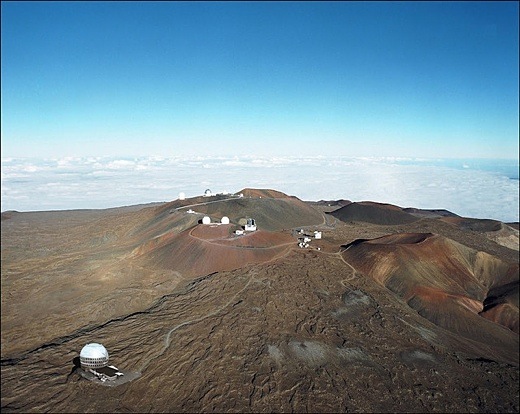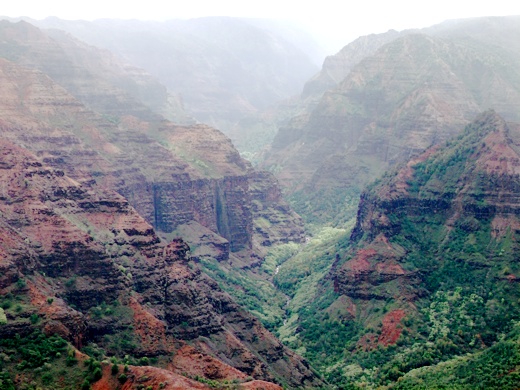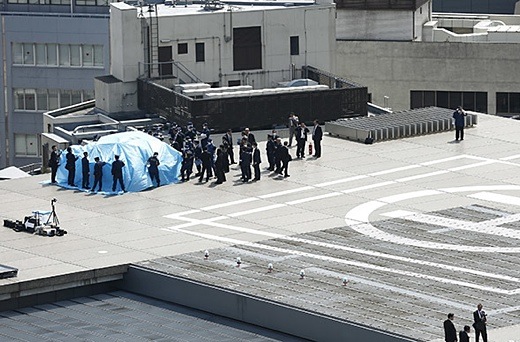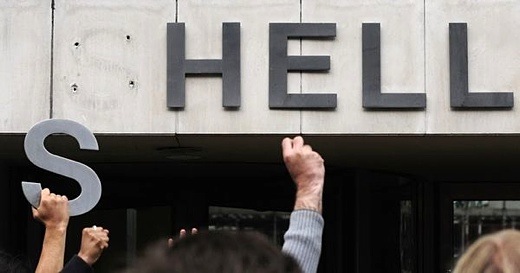SUBHEAD: Unlike the death of the telegraph, the death of the internet won't be a harbinger for something bigger and better.
By John Michael Greer on 29 April 2015 for Archdruid Report -
(http://thearchdruidreport.blogspot.com/2015/04/the-death-of-internet-pre-mortem.html)

Image above: Rendering of a PanAm version of the Boeing 2707 SST circa 1968. From (http://theconcordestory.com/concorde/gallery/photographs/competitors-2/boeing-2707/).
The mythic role assigned to progress in today’s popular culture has any number of odd effects, but one of the strangest is the blindness to the downside that clamps down on the collective imagination of our time once people become convinced that something or other is the wave of the future.
It doesn’t matter in the least how many or obvious the warning signs are, or how many times the same tawdry drama has been enacted.
Once some shiny new gimmick gets accepted as the next glorious step in the invincible march of progress, most people lose the ability to imagine that the wave of the future might just do what waves generally do: that is to say, crest, break, and flow back out to sea, leaving debris scattered on the beach in its wake.
It so happens that I grew up in the middle of just such a temporary wave of the future, in the south Seattle suburbs in the 1960s, where every third breadwinner worked for Boeing. The wave in question was the supersonic transport, SST for short: a jetliner that would fly faster than sound, cutting hours off long flights.
The inevitability of the SST was an article of faith locally, and not just because Boeing was building one; an Anglo-French consortium was in the lead with the Concorde, and the Soviets were working on the Tu-144, but the Boeing 2707 was expected to be the biggest and baddest of them all, a 300-seat swing-wing plane that was going to make commercial supersonic flight an everyday reality.
Long before the 2707 had even the most ghostly sort of reality, you could buy model kits of the plane, complete with Pan Am decals, at every hobby store in the greater Seattle area.
For that matter, take Interstate 5 south from downtown Seattle past the sprawling Boeing plant just outside of town, and you’d see the image of the 2707 on the wall of one of the huge assembly buildings, a big delta-winged shape in white and gold winging its way through the imagined air toward the gleaming future in which so many people believed back then.
There was, as it happened, a small problem with the 2707, a problem it shared with all the other SST projects; it made no economic sense at all.
It was, to be precise, what an earlier post here called a subsidy dumpster: that is, a project that was technically feasible but economically impractical, and existed mostly as a way to pump government subsidies into Boeing’s coffers.
Come 1971, the well ran dry: faced with gloomy numbers from the economists, worried calculations from environmental scientists, and a public not exactly enthusiastic about dozens of sonic booms a day rattling plates and cracking windows around major airports, Congress cut the project’s funding.
That happened right when the US economy generally, and the notoriously cyclical airplane industry in particular, were hitting downturns.
>Boeing was Seattle’s biggest employer in those days, and when it laid off employees en masse, the result was a local depression of legendary severity. You heard a lot of people in those days insisting that the US had missed out on the next aviation boom, and Congress would have to hang its head in shame once Concordes and Tu-144s were hauling passengers all over the globe.
Of course that’s not what happened. The Tu-144 flew a handful of commercial flights and then was grounded for safety reasons, and the Concorde lingered on, a technical triumph but an economic white elephant, until the last plane retired from service in 2003.
All this has been on my mind of late as I’ve considered the future of the internet. The comparison may seem far-fetched, but then that’s what supporters of the SST would have said if anyone had compared the Boeing 2707 to, say, the zeppelin, another wave of the future that turned out to make too little economic sense to matter.
Granted, the internet isn’t a subsidy dumpster, and it’s also much more complex than the SST; if anything, it might be compared to the entire system of commercial air travel, which we still have with us or the moment.
Nonetheless, a strong case can be made that the internet, like the SST, doesn’t actually make economic sense; it’s being propped up by a set of financial gimmickry with a distinct resemblance to smoke and mirrors; and when those go away—and they will—much of what makes the internet so central a part of pop culture will go away as well.
It’s probably necessary to repeat here that the reasons for this are economic, not technical. Every time I’ve discussed the hard economic realities that make the internet’s lifespan in the deindustrial age roughly that of a snowball in Beelzebub’s back yard, I’ve gotten a flurry of responses fixating on purely technical issues.
Those issues are beside the point.
No doubt it would be possible to make something like the internet technically feasible in a society on the far side of the Long Descent, but that doesn’t matter; what matters is that the internet has to cover its operating costs, and it also has to compete with other ways of doing the things that the internet currently does.
It’s a source of wry amusement to me that so many people seem to have forgotten that the internet doesn’t actually do very much that’s new.
Long before the internet, people were reading the news, publishing essays and stories, navigating through unfamiliar neighborhoods, sharing photos of kittens with their friends, ordering products from faraway stores for home delivery, looking at pictures of people with their clothes off, sending anonymous hate-filled messages to unsuspecting recipients, and doing pretty much everything else that they do on the internet today.
For the moment, doing these things on the internet is cheaper and more convenient than the alternatives, and that’s what makes the internet so popular. If that changes—if the internet becomes more costly and less convenient than other options—its current popularity is unlikely to last.
Let’s start by looking at the costs. Every time I’ve mentioned the future of the internet on this blog, I’ve gotten comments and emails from readers who think that the price of their monthly internet service is a reasonable measure of the cost of the internet as a whole.
For a useful corrective to this delusion, talk to people who work in data centers. You’ll hear about trucks pulling up to the loading dock every single day to offload pallet after pallet of brand new hard drives and other components, to replace those that will burn out that same day. You’ll hear about power bills that would easily cover the electricity costs of a small city. You’ll hear about many other costs as well.
Data centers are not cheap to run, there are many thousands of them, and they’re only one part of the vast infrastructure we call the internet: by many measures, the most gargantuan technological project in the history of our species.
Your monthly fee for internet service covers only a small portion of what the internet costs. Where does the rest come from? That depends on which part of the net we’re discussing.
The basic structure is paid for by internet service providers (ISPs), who recoup part of the costs from your monthly fee, part from the much larger fees paid by big users, and part by advertising.
Content providers use some mix of advertising, pay-to-play service fees, sales of goods and services, packaging and selling your personal data to advertisers and government agencies, and new money from investors and loans to meet their costs.
The ISPs routinely make a modest profit on the deal, but many of the content providers do not.
Amazon may be the biggest retailer on the planet, for example, and its cash flow has soared in recent years, but its expenses have risen just as fast, and it rarely makes a profit. Many other content provider firms, including fish as big as Twitter, rack up big losses year after year.
How do they stay in business?
A combination of vast amounts of investment money and ultracheap debt. That’s very common in the early decades of a new industry, though it’s been made a good deal easier by the Fed’s policy of next-to-zero interest rates.
Investors who dream of buying stock in the next Microsoft provide venture capital for internet startups, banks provide lines of credit for existing firms, the stock and bond markets snap up paper of various kinds churned out by internet businesses, and all that money goes to pay the bills.
any of the firms they’re funding will go belly up within a few years, but the few that don’t will either be bought up at inflated prices by one of the big dogs of the online world, or will figure out how to make money and then become big dogs themselves.
Notice, though, that this process has an unexpected benefit for ordinary internet users: a great many services are available for free, because venture-capital investors and lines of credit are footing the bill for the time being.
Boosting the number of page views and clickthroughs is far more important for the future of an internet company these days than making a profit, and so the usual business plan is to provide plenty of free goodies to the public without worrying about the financial end of things.
That’s very convenient just now for internet users, but it fosters the illusion that the internet costs nothing.
As mentioned earlier, this sort of thing is very common in the early decades of a new industry. As the industry matures, markets become saturated, startups become considerably riskier, and venture capital heads for greener pastures.
Once this happens, the companies that dominate the industry have to stay in business the old-fashioned way, by earning a profit, and that means charging as much as the market will bear, monetizing services that are currently free, and cutting service to the lowest level that customers will tolerate.
That’s business as usual, and it means the end of most of the noncommercial content that gives the internet so much of its current role in popular culture.
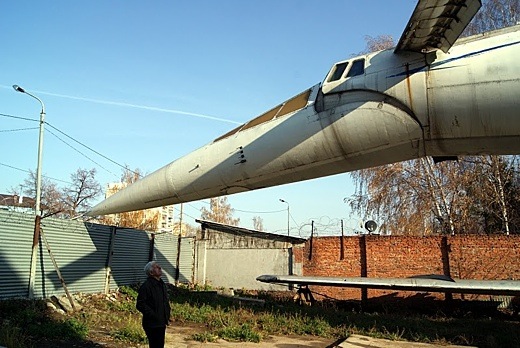
Image above: A Tupelev TU-144 SST in 2010, as it has sats since 1985, in a yard outside of the Kazan Institute of Aviation in the former Soviet Union. From (http://www.tu144sst.com/fleet/05-1.html).
All other things being equal, in other words, the internet can be expected to follow the usual trajectory of a maturing industry, becoming more expensive, less convenient, and more tightly focused on making a quick buck with each passing year.
Governments have already begun to tax internet sales, removing one of the core “stealth subsidies” that boosted the internet at the expense of other retail sectors, and taxation of the internet will only increase as cash-starved officials contemplate the tidal waves of money sloshing back and forth online.
None of these changes will kill the internet, but they’ll slap limits on the more utopian fantasies currently burbling about the web, and provide major incentives for individuals and businesses to back away from the internet and do things in the real world instead.
Then there’s the increasingly murky world of online crime, espionage, and warfare, which promises to push very hard in the same direction in the years ahead.
I think most people are starting to realize that on the internet, there’s no such thing as secure data, and the costs of conducting business online these days include a growing risk of having your credit cards stolen, your bank accounts looted, your identity borrowed for any number of dubious purposes, and the files on your computer encrypted without your knowledge, so that you can be forced to pay a ransom for their release—this latter, or so I’ve read, is the latest hot new trend in internet crime.
Online crime is one of the few fields of criminal endeavor in which raw cleverness is all you need to make out, as the saying goes, like a bandit.
In the years ahead, as a result, the internet may look less like an information superhighway and more like one of those grim inner city streets where not even the muggers go alone. Trends in online espionage and warfare are harder to track, but either or both could become a serious burden on the internet as well.
Online crime, espionage, and warfare aren’t going to kill the internet, any more than the ordinary maturing of the industry will. Rather, they’ll lead to a future in which costs of being online are very often greater than the benefits, and the internet is by and large endured rather than enjoyed. They’ll also help drive the inevitable rebound away from the net.
That’s one of those things that always happens and always blindsides the cheerleaders of the latest technology: a few decades into its lifespan, people start to realize that they liked the old technology better, thank you very much, and go back to it.
The rebound away from the internet has already begun, and will only become more visible as time goes on, making a great many claims about the future of the internet look as absurd as those 1950s articles insisting that in the future, every restaurant would inevitably be a drive-in.
To be sure, the resurgence of live theater in the wake of the golden age of movie theaters didn’t end cinema, and the revival of bicycling in the aftermath of the automobile didn’t make cars go away.
In the same way, the renewal of interest in offline practices and technologies isn’t going to make the internet go away. It’s simply going to accelerate the shift of avant-garde culture away from an increasingly bleak, bland, unsafe, and corporate- and government-controlled internet and into alternative venues.
That won’t kill the internet, though once again it will put a stone marked R.I.P. atop the grave of a lot of the utopian fantasies that have clustered around today’s net culture.
All other things being equal, in fact, there’s no reason why the internet couldn’t keep on its present course for years to come.
Under those circumstances, it would shed most of the features that make it popular with today’s avant-garde, and become one more centralized, regulated, vacuous mass medium, packed to the bursting point with corporate advertising and lowest-common-denominator content, with dissenting voices and alternative culture shut out or shoved into corners where nobody ever looks.
That’s the normal trajectory of an information technology in today’s industrial civilization, after all; it’s what happened with radio and television in their day, as the gaudy and grandiose claims of the early years gave way to the crass commercial realities of the mature forms of each medium.
But all other things aren’t equal.
Radio and television, like most of the other familiar technologies that define life in a modern industrial society, were born and grew to maturity in an expanding economy.
The internet, by contrast, was born during the last great blowoff of the petroleum age—the last decades of the twentieth century, during which the world’s industrial nations took the oil reserves that might have cushioned the transition to sustainability, and blew them instead on one last orgy of over-the-top conspicuous consumption—and it’s coming to maturity in the early years of an age of economic contraction and ecological blowback.
The rising prices, falling service quality, and relentless monetization of a maturing industry, together with the increasing burden of online crime and the inevitable rebound away from internet culture, will thus be hitting the internet in a time when the global economy no longer has the slack it once did, and the immense costs of running the internet in anything like its present form will have to be drawn from a pool of real wealth that has many other demands on it.
What’s more, quite a few of those other demands will be far more urgent than the need to provide consumers with a convenient way to send pictures of kittens to their friends. That stark reality will add to the pressure to monetize internet services, and provide incentives to those who choose to send their kitten pictures by other means.
It’s crucial to remember here, as noted above, that the internet is simply a cheaper and more convenient way of doing things that people were doing long before the first website went live, and a big part of the reason why it’s cheaper and more convenient right now is that internet users are being subsidized by the investors and venture capitalists who are funding the internet industry. That’s not the only subsidy on which the internet depends, though.
Along with the rest of industrial society, it’s also subsidized by half a billion years of concentrated solar energy in the form of fossil fuels.
As those deplete, the vast inputs of energy, labor, raw materials, industrial products, and other forms of wealth that sustain the internet will become increasingly expensive to provide, and ways of distributing kitten pictures that don’t require the same inputs will prosper in the resulting competition.
There are also crucial issues of scale. Most pre-internet communications and information technologies scale down extremely well.
A community of relatively modest size can have its own public library, its own small press, its own newspaper, and its own radio station running local programming, and could conceivably keep all of these functioning and useful even if the rest of humanity suddenly vanished from the map. Internet technology doesn’t have that advantage.
It’s orders of magnitude more complex and expensive than a radio transmitter, not to mention the 14th-century technology of printing presses and card catalogs; what’s more, on the scale of a small community, the benefits of using internet technology instead of simpler equivalents wouldn’t come close to justifying the vast additional cost.
Now of course the world of the future isn’t going to consist of a single community surrounded by desolate wasteland. That’s one of the reasons why the demise of the internet won’t happen all at once.
Telecommunications companies serving some of the more impoverished parts of rural America are already letting their networks in those areas degrade, since income from customers doesn’t cover the costs of maintenance.
To my mind, that’s a harbinger of the internet’s future—a future of uneven decline punctuated by local and regional breakdowns, some of which will be fixed for a while.
That said, it’s quite possible that there will still be an internet of some sort fifty years from now. It will connect government agencies, military units, defense contractors, and the handful of universities that survive the approaching implosion of the academic industry here in the US, and it may provide email and a few other services to the very rich, but it will otherwise have a lot more in common with the original DARPAnet than with the 24/7 virtual cosmos imagined by today’s more gullible netheads.
Unless you’re one of the very rich or an employee of one of the institutions just named, furthermore, you won’t have access to the internet of 2065.
You might be able to hack into it, if you have the necessary skills and are willing to risk a long stint in a labor camp, but unless you’re a criminal or a spy working for the insurgencies flaring in the South or the mountain West, there’s not much point to the stunt.
If you’re like most Americans in 2065, you live in Third World conditions without regular access to electricity or running water, and you’ve got other ways to buy things, find out what’s going on in the world, find out how to get to the next town and, yes, look at pictures of people with their clothes off.
What’s more, in a deindustrializing world, those other ways of doing things will be cheaper, more resilient, and more useful than reliance on the baroque intricacies of a vast computer net.
Exactly when the last vestiges of the internet will sputter to silence is a harder question to answer.
Long before that happens, though, it will have lost its current role as one of the poster children of the myth of perpetual progress, and turned back into what it really was all the time: a preposterously complex way to do things most people have always done by much simpler means, which only seemed to make sense during that very brief interval of human history when fossil fuels were abundant and cheap.
.
By John Michael Greer on 29 April 2015 for Archdruid Report -
(http://thearchdruidreport.blogspot.com/2015/04/the-death-of-internet-pre-mortem.html)

Image above: Rendering of a PanAm version of the Boeing 2707 SST circa 1968. From (http://theconcordestory.com/concorde/gallery/photographs/competitors-2/boeing-2707/).
The mythic role assigned to progress in today’s popular culture has any number of odd effects, but one of the strangest is the blindness to the downside that clamps down on the collective imagination of our time once people become convinced that something or other is the wave of the future.
It doesn’t matter in the least how many or obvious the warning signs are, or how many times the same tawdry drama has been enacted.
Once some shiny new gimmick gets accepted as the next glorious step in the invincible march of progress, most people lose the ability to imagine that the wave of the future might just do what waves generally do: that is to say, crest, break, and flow back out to sea, leaving debris scattered on the beach in its wake.
It so happens that I grew up in the middle of just such a temporary wave of the future, in the south Seattle suburbs in the 1960s, where every third breadwinner worked for Boeing. The wave in question was the supersonic transport, SST for short: a jetliner that would fly faster than sound, cutting hours off long flights.
The inevitability of the SST was an article of faith locally, and not just because Boeing was building one; an Anglo-French consortium was in the lead with the Concorde, and the Soviets were working on the Tu-144, but the Boeing 2707 was expected to be the biggest and baddest of them all, a 300-seat swing-wing plane that was going to make commercial supersonic flight an everyday reality.
Long before the 2707 had even the most ghostly sort of reality, you could buy model kits of the plane, complete with Pan Am decals, at every hobby store in the greater Seattle area.
For that matter, take Interstate 5 south from downtown Seattle past the sprawling Boeing plant just outside of town, and you’d see the image of the 2707 on the wall of one of the huge assembly buildings, a big delta-winged shape in white and gold winging its way through the imagined air toward the gleaming future in which so many people believed back then.
There was, as it happened, a small problem with the 2707, a problem it shared with all the other SST projects; it made no economic sense at all.
It was, to be precise, what an earlier post here called a subsidy dumpster: that is, a project that was technically feasible but economically impractical, and existed mostly as a way to pump government subsidies into Boeing’s coffers.
Come 1971, the well ran dry: faced with gloomy numbers from the economists, worried calculations from environmental scientists, and a public not exactly enthusiastic about dozens of sonic booms a day rattling plates and cracking windows around major airports, Congress cut the project’s funding.
That happened right when the US economy generally, and the notoriously cyclical airplane industry in particular, were hitting downturns.
>Boeing was Seattle’s biggest employer in those days, and when it laid off employees en masse, the result was a local depression of legendary severity. You heard a lot of people in those days insisting that the US had missed out on the next aviation boom, and Congress would have to hang its head in shame once Concordes and Tu-144s were hauling passengers all over the globe.
Of course that’s not what happened. The Tu-144 flew a handful of commercial flights and then was grounded for safety reasons, and the Concorde lingered on, a technical triumph but an economic white elephant, until the last plane retired from service in 2003.
All this has been on my mind of late as I’ve considered the future of the internet. The comparison may seem far-fetched, but then that’s what supporters of the SST would have said if anyone had compared the Boeing 2707 to, say, the zeppelin, another wave of the future that turned out to make too little economic sense to matter.
Granted, the internet isn’t a subsidy dumpster, and it’s also much more complex than the SST; if anything, it might be compared to the entire system of commercial air travel, which we still have with us or the moment.
Nonetheless, a strong case can be made that the internet, like the SST, doesn’t actually make economic sense; it’s being propped up by a set of financial gimmickry with a distinct resemblance to smoke and mirrors; and when those go away—and they will—much of what makes the internet so central a part of pop culture will go away as well.
It’s probably necessary to repeat here that the reasons for this are economic, not technical. Every time I’ve discussed the hard economic realities that make the internet’s lifespan in the deindustrial age roughly that of a snowball in Beelzebub’s back yard, I’ve gotten a flurry of responses fixating on purely technical issues.
Those issues are beside the point.
No doubt it would be possible to make something like the internet technically feasible in a society on the far side of the Long Descent, but that doesn’t matter; what matters is that the internet has to cover its operating costs, and it also has to compete with other ways of doing the things that the internet currently does.
It’s a source of wry amusement to me that so many people seem to have forgotten that the internet doesn’t actually do very much that’s new.
Long before the internet, people were reading the news, publishing essays and stories, navigating through unfamiliar neighborhoods, sharing photos of kittens with their friends, ordering products from faraway stores for home delivery, looking at pictures of people with their clothes off, sending anonymous hate-filled messages to unsuspecting recipients, and doing pretty much everything else that they do on the internet today.
For the moment, doing these things on the internet is cheaper and more convenient than the alternatives, and that’s what makes the internet so popular. If that changes—if the internet becomes more costly and less convenient than other options—its current popularity is unlikely to last.
Let’s start by looking at the costs. Every time I’ve mentioned the future of the internet on this blog, I’ve gotten comments and emails from readers who think that the price of their monthly internet service is a reasonable measure of the cost of the internet as a whole.
For a useful corrective to this delusion, talk to people who work in data centers. You’ll hear about trucks pulling up to the loading dock every single day to offload pallet after pallet of brand new hard drives and other components, to replace those that will burn out that same day. You’ll hear about power bills that would easily cover the electricity costs of a small city. You’ll hear about many other costs as well.
Data centers are not cheap to run, there are many thousands of them, and they’re only one part of the vast infrastructure we call the internet: by many measures, the most gargantuan technological project in the history of our species.
Your monthly fee for internet service covers only a small portion of what the internet costs. Where does the rest come from? That depends on which part of the net we’re discussing.
The basic structure is paid for by internet service providers (ISPs), who recoup part of the costs from your monthly fee, part from the much larger fees paid by big users, and part by advertising.
Content providers use some mix of advertising, pay-to-play service fees, sales of goods and services, packaging and selling your personal data to advertisers and government agencies, and new money from investors and loans to meet their costs.
The ISPs routinely make a modest profit on the deal, but many of the content providers do not.
Amazon may be the biggest retailer on the planet, for example, and its cash flow has soared in recent years, but its expenses have risen just as fast, and it rarely makes a profit. Many other content provider firms, including fish as big as Twitter, rack up big losses year after year.
How do they stay in business?
A combination of vast amounts of investment money and ultracheap debt. That’s very common in the early decades of a new industry, though it’s been made a good deal easier by the Fed’s policy of next-to-zero interest rates.
Investors who dream of buying stock in the next Microsoft provide venture capital for internet startups, banks provide lines of credit for existing firms, the stock and bond markets snap up paper of various kinds churned out by internet businesses, and all that money goes to pay the bills.
any of the firms they’re funding will go belly up within a few years, but the few that don’t will either be bought up at inflated prices by one of the big dogs of the online world, or will figure out how to make money and then become big dogs themselves.
Notice, though, that this process has an unexpected benefit for ordinary internet users: a great many services are available for free, because venture-capital investors and lines of credit are footing the bill for the time being.
Boosting the number of page views and clickthroughs is far more important for the future of an internet company these days than making a profit, and so the usual business plan is to provide plenty of free goodies to the public without worrying about the financial end of things.
That’s very convenient just now for internet users, but it fosters the illusion that the internet costs nothing.
As mentioned earlier, this sort of thing is very common in the early decades of a new industry. As the industry matures, markets become saturated, startups become considerably riskier, and venture capital heads for greener pastures.
Once this happens, the companies that dominate the industry have to stay in business the old-fashioned way, by earning a profit, and that means charging as much as the market will bear, monetizing services that are currently free, and cutting service to the lowest level that customers will tolerate.
That’s business as usual, and it means the end of most of the noncommercial content that gives the internet so much of its current role in popular culture.

Image above: A Tupelev TU-144 SST in 2010, as it has sats since 1985, in a yard outside of the Kazan Institute of Aviation in the former Soviet Union. From (http://www.tu144sst.com/fleet/05-1.html).
All other things being equal, in other words, the internet can be expected to follow the usual trajectory of a maturing industry, becoming more expensive, less convenient, and more tightly focused on making a quick buck with each passing year.
Governments have already begun to tax internet sales, removing one of the core “stealth subsidies” that boosted the internet at the expense of other retail sectors, and taxation of the internet will only increase as cash-starved officials contemplate the tidal waves of money sloshing back and forth online.
None of these changes will kill the internet, but they’ll slap limits on the more utopian fantasies currently burbling about the web, and provide major incentives for individuals and businesses to back away from the internet and do things in the real world instead.
Then there’s the increasingly murky world of online crime, espionage, and warfare, which promises to push very hard in the same direction in the years ahead.
I think most people are starting to realize that on the internet, there’s no such thing as secure data, and the costs of conducting business online these days include a growing risk of having your credit cards stolen, your bank accounts looted, your identity borrowed for any number of dubious purposes, and the files on your computer encrypted without your knowledge, so that you can be forced to pay a ransom for their release—this latter, or so I’ve read, is the latest hot new trend in internet crime.
Online crime is one of the few fields of criminal endeavor in which raw cleverness is all you need to make out, as the saying goes, like a bandit.
In the years ahead, as a result, the internet may look less like an information superhighway and more like one of those grim inner city streets where not even the muggers go alone. Trends in online espionage and warfare are harder to track, but either or both could become a serious burden on the internet as well.
Online crime, espionage, and warfare aren’t going to kill the internet, any more than the ordinary maturing of the industry will. Rather, they’ll lead to a future in which costs of being online are very often greater than the benefits, and the internet is by and large endured rather than enjoyed. They’ll also help drive the inevitable rebound away from the net.
That’s one of those things that always happens and always blindsides the cheerleaders of the latest technology: a few decades into its lifespan, people start to realize that they liked the old technology better, thank you very much, and go back to it.
The rebound away from the internet has already begun, and will only become more visible as time goes on, making a great many claims about the future of the internet look as absurd as those 1950s articles insisting that in the future, every restaurant would inevitably be a drive-in.
To be sure, the resurgence of live theater in the wake of the golden age of movie theaters didn’t end cinema, and the revival of bicycling in the aftermath of the automobile didn’t make cars go away.
In the same way, the renewal of interest in offline practices and technologies isn’t going to make the internet go away. It’s simply going to accelerate the shift of avant-garde culture away from an increasingly bleak, bland, unsafe, and corporate- and government-controlled internet and into alternative venues.
That won’t kill the internet, though once again it will put a stone marked R.I.P. atop the grave of a lot of the utopian fantasies that have clustered around today’s net culture.
All other things being equal, in fact, there’s no reason why the internet couldn’t keep on its present course for years to come.
Under those circumstances, it would shed most of the features that make it popular with today’s avant-garde, and become one more centralized, regulated, vacuous mass medium, packed to the bursting point with corporate advertising and lowest-common-denominator content, with dissenting voices and alternative culture shut out or shoved into corners where nobody ever looks.
That’s the normal trajectory of an information technology in today’s industrial civilization, after all; it’s what happened with radio and television in their day, as the gaudy and grandiose claims of the early years gave way to the crass commercial realities of the mature forms of each medium.
But all other things aren’t equal.
Radio and television, like most of the other familiar technologies that define life in a modern industrial society, were born and grew to maturity in an expanding economy.
The internet, by contrast, was born during the last great blowoff of the petroleum age—the last decades of the twentieth century, during which the world’s industrial nations took the oil reserves that might have cushioned the transition to sustainability, and blew them instead on one last orgy of over-the-top conspicuous consumption—and it’s coming to maturity in the early years of an age of economic contraction and ecological blowback.
The rising prices, falling service quality, and relentless monetization of a maturing industry, together with the increasing burden of online crime and the inevitable rebound away from internet culture, will thus be hitting the internet in a time when the global economy no longer has the slack it once did, and the immense costs of running the internet in anything like its present form will have to be drawn from a pool of real wealth that has many other demands on it.
What’s more, quite a few of those other demands will be far more urgent than the need to provide consumers with a convenient way to send pictures of kittens to their friends. That stark reality will add to the pressure to monetize internet services, and provide incentives to those who choose to send their kitten pictures by other means.
It’s crucial to remember here, as noted above, that the internet is simply a cheaper and more convenient way of doing things that people were doing long before the first website went live, and a big part of the reason why it’s cheaper and more convenient right now is that internet users are being subsidized by the investors and venture capitalists who are funding the internet industry. That’s not the only subsidy on which the internet depends, though.
Along with the rest of industrial society, it’s also subsidized by half a billion years of concentrated solar energy in the form of fossil fuels.
As those deplete, the vast inputs of energy, labor, raw materials, industrial products, and other forms of wealth that sustain the internet will become increasingly expensive to provide, and ways of distributing kitten pictures that don’t require the same inputs will prosper in the resulting competition.
There are also crucial issues of scale. Most pre-internet communications and information technologies scale down extremely well.
A community of relatively modest size can have its own public library, its own small press, its own newspaper, and its own radio station running local programming, and could conceivably keep all of these functioning and useful even if the rest of humanity suddenly vanished from the map. Internet technology doesn’t have that advantage.
It’s orders of magnitude more complex and expensive than a radio transmitter, not to mention the 14th-century technology of printing presses and card catalogs; what’s more, on the scale of a small community, the benefits of using internet technology instead of simpler equivalents wouldn’t come close to justifying the vast additional cost.
Now of course the world of the future isn’t going to consist of a single community surrounded by desolate wasteland. That’s one of the reasons why the demise of the internet won’t happen all at once.
Telecommunications companies serving some of the more impoverished parts of rural America are already letting their networks in those areas degrade, since income from customers doesn’t cover the costs of maintenance.
To my mind, that’s a harbinger of the internet’s future—a future of uneven decline punctuated by local and regional breakdowns, some of which will be fixed for a while.
That said, it’s quite possible that there will still be an internet of some sort fifty years from now. It will connect government agencies, military units, defense contractors, and the handful of universities that survive the approaching implosion of the academic industry here in the US, and it may provide email and a few other services to the very rich, but it will otherwise have a lot more in common with the original DARPAnet than with the 24/7 virtual cosmos imagined by today’s more gullible netheads.
Unless you’re one of the very rich or an employee of one of the institutions just named, furthermore, you won’t have access to the internet of 2065.
You might be able to hack into it, if you have the necessary skills and are willing to risk a long stint in a labor camp, but unless you’re a criminal or a spy working for the insurgencies flaring in the South or the mountain West, there’s not much point to the stunt.
If you’re like most Americans in 2065, you live in Third World conditions without regular access to electricity or running water, and you’ve got other ways to buy things, find out what’s going on in the world, find out how to get to the next town and, yes, look at pictures of people with their clothes off.
What’s more, in a deindustrializing world, those other ways of doing things will be cheaper, more resilient, and more useful than reliance on the baroque intricacies of a vast computer net.
Exactly when the last vestiges of the internet will sputter to silence is a harder question to answer.
Long before that happens, though, it will have lost its current role as one of the poster children of the myth of perpetual progress, and turned back into what it really was all the time: a preposterously complex way to do things most people have always done by much simpler means, which only seemed to make sense during that very brief interval of human history when fossil fuels were abundant and cheap.
.

